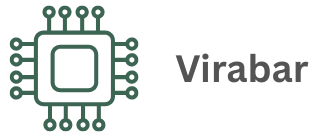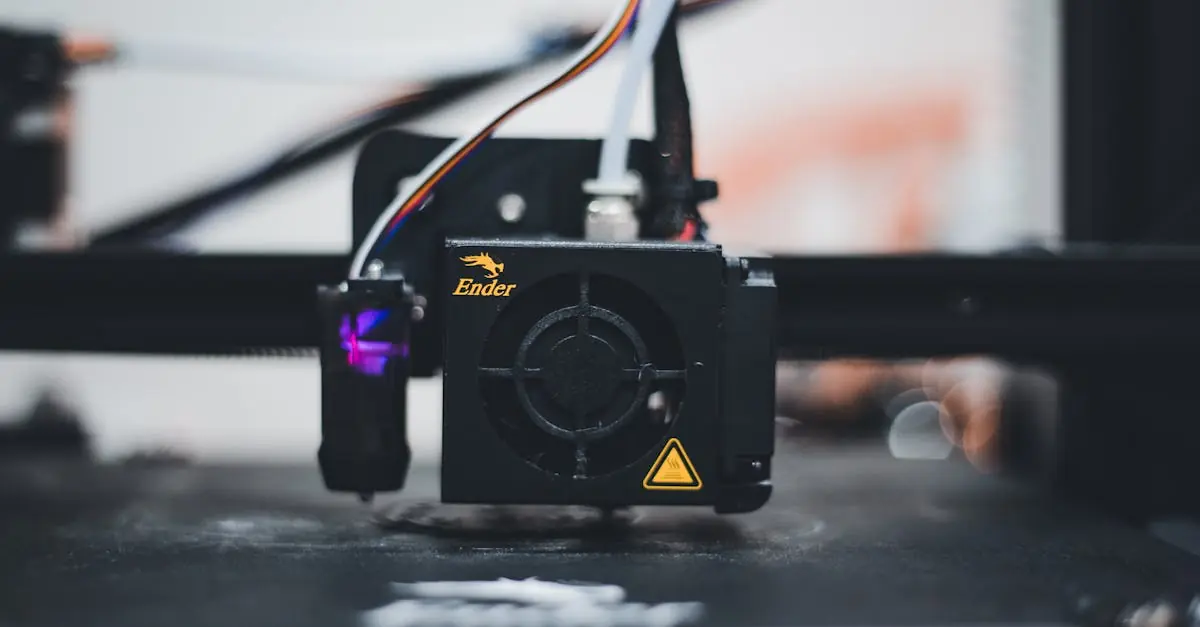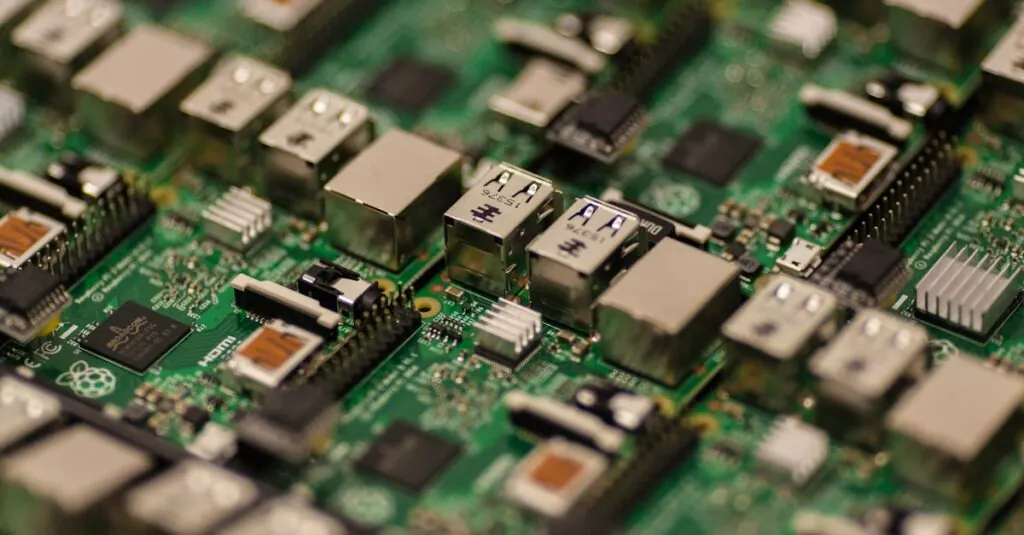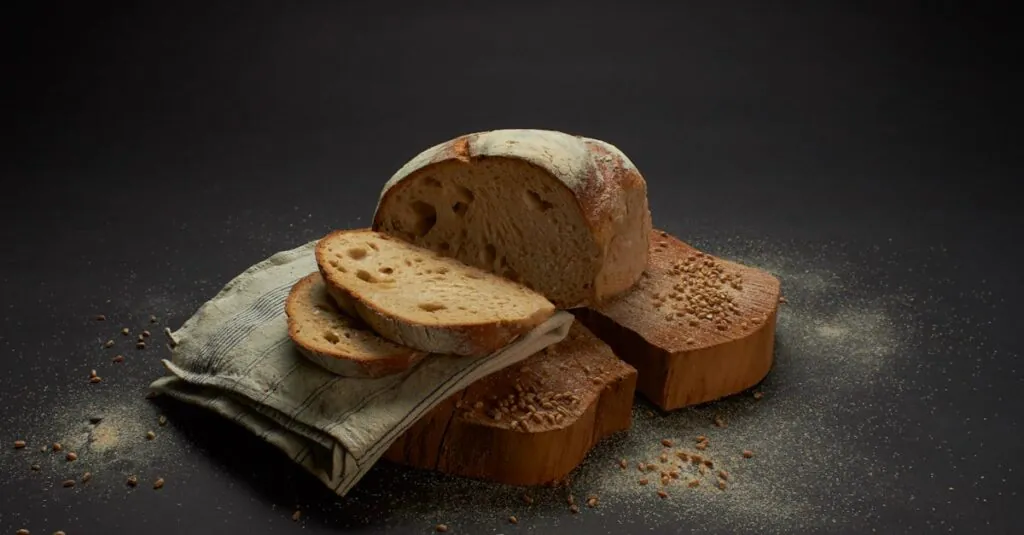Table of Contents
ToggleIn the world of 3D printing, the extruder is the unsung hero, tirelessly turning filament into fabulous creations. But not all extruders are created equal. Just like choosing between a latte and a cappuccino, picking the right extruder can make or break your printing experience. Whether you’re a hobbyist crafting miniature landscapes or a professional whipping up prototypes, understanding the different types of extruders is crucial.
Overview of 3D Printer Extruder Types
Different types of 3D printer extruders serve distinct purposes, impacting overall printing results. Two primary types are direct drive and Bowden extruders. Direct drive extruders mount directly on the print head, providing better control over filament feeding. They excel in handling flexible filaments and ensuring consistent extrusion.
Bowden extruders, in contrast, separate the motor from the print head. This design dramatically reduces moving mass, allowing for faster print speeds. However, they may struggle with flexible filaments due to the added distance for filament movement.
Another variant includes the geared extruder. This type uses gears to enhance torque, making it easier to push challenging filaments. Its setup benefits users who frequently switch between material types requiring different feeding pressures.
Some printers utilize multi-material extruders, which enable printing with diverse filaments in a single job. This functionality enhances design possibilities but demands precise calibration to avoid filament jamming or clogging.
The choice of extruder impacts a 3D printing project significantly. Users must consider factors like filament type, print speed, and object complexity. Each extruder type has unique attributes, making them suitable for specific applications and filament behaviors. Understanding these differences ensures optimal performance and successful outcomes in 3D printing projects.
Direct Drive Extruders
Direct drive extruders mount directly on the print head, providing numerous benefits for 3D printing. This connection allows for precise control over filament feeding, making it easier to handle various filament types, especially flexible materials.
Advantages of Direct Drive Extruders
One major advantage includes improved filament control, which enhances print quality. These extruders excel in handling flexible filaments like TPU without causing jams. Direct drive systems also minimize lag during printing, leading to faster response times when the printer switches between filaments. The lightweight design improves accuracy in print details and reduces stringing. Users appreciate how they can swiftly adjust setting parameters for different materials, allowing for diverse projects.
Disadvantages of Direct Drive Extruders
Despite their benefits, direct drive extruders also have drawbacks. One significant downside is increased weight on the print head, which can affect overall speed. The added mass may lead to challenges with high-speed prints, as it can introduce vibrations. Additionally, direct drive extruders generally require more maintenance due to their exposure to heat and wear. These systems can complicate upgrades, especially if significant modifications to the printer frame occur. Users must consider these factors when deciding on the right extruder type for their specific printing needs.
Bowden Extruders
Bowden extruders separate the filament drive mechanism from the print head. This design allows for faster print speeds due to reduced moving mass.
Advantages of Bowden Extruders
Bowden extruders excel in speed thanks to their lightweight configuration. They reduce inertia during printing, enhancing overall print time and responsiveness. Filament routing through a tube minimizes friction, contributing to smoother filament feeding. Users often find that these extruders enable greater print accuracy, especially with rigid filaments. Maintenance is simpler since the motor remains stationary on the frame. They also accommodate larger print heads, facilitating more intricate designs without added weight on the nozzle.
Disadvantages of Bowden Extruders
Bowden extruders may struggle with flexible filaments due to increased distance between the extruder and the hotend. This added distance can lead to filament compression, which results in inferior print quality. Users also report challenges with material retraction settings, requiring fine-tuning for optimal performance. Jamming occurs more frequently when printing with softer materials, which can frustrate users. Additionally, adjusting to different filaments necessitates more experimentation compared to direct drive systems. These limitations may affect reliability during complex print jobs.
Other Extruder Types
Various extruder types cater to specific printing needs. Each of these types enhances functionality in unique ways.
Multi-Material Extruders
Multi-material extruders enable the use of different filament types in a single print job. These extruders typically feature multiple nozzles that allow for seamless transitions between materials. Users can create complex models that combine both rigid and flexible filaments. Improved versatility allows for innovative designs and intricate color variations. One drawback includes increased setup complexity, where calibration becomes essential to achieve successful prints. This type is ideal for advanced users looking to expand their creative possibilities.
Specialized Extruders
Specialized extruders target specific materials or unique printing techniques. For example, some are optimized for high-temperature filaments like nylon or carbon fiber. Other specialized extruders handle exotic materials such as ceramics or even food-grade substances. Different designs allow for precise control, ensuring optimal extrusion rates and minimizing clogs. Users can achieve specialized textures or properties, catering to unique project requirements. Costs often increase due to added features, making careful selection crucial based on individual printing goals.
Choosing the Right Extruder for Your Needs
Selecting the appropriate extruder significantly influences the quality and efficiency of 3D prints. Direct drive extruders excel at handling flexible materials, making them ideal for projects involving versatile filaments like TPU. Enthusiasts appreciate the precise filament control and improved print quality offered by these extruders.
However, a trade-off exists when it comes to weight. Heavier extruders can introduce vibrations and affect print speeds. Therefore, users should consider their printer’s capabilities alongside the advantages of direct drive systems.
Bowden extruders, on the other hand, focus on reducing moving mass. Their design results in faster print speeds and improved precision with rigid materials. For users engaged in large or complex projects, these advantages are appealing.
Despite the benefits, Bowden extruders face challenges with flexible filaments. Increased distance from the hotend can lead to potential jamming, requiring careful adjustment of retraction settings. This aspect should not be overlooked by those who frequently work with diverse filament types.
Multi-material extruders cater to users seeking versatility. These systems allow for the use of different filament types within a single print job, enabling creative designs. They come equipped with multiple nozzles, enhancing transitions but also complicating the setup process.
Specialized extruders present another possibility for specific needs. These options target unique materials or techniques, like high-temperature filaments. Users aiming for niche projects must consider the increased cost while selecting a specialized extruder. Each decision impacts the ultimate outcome of 3D printing endeavors.
Conclusion
Choosing the right 3D printer extruder is crucial for achieving optimal results in any printing project. Each type of extruder offers unique benefits and challenges that can significantly influence print quality and efficiency. Whether a user opts for a direct drive extruder for its precision with flexible materials or a Bowden extruder for speed with rigid filaments, understanding these options is essential. Multi-material and specialized extruders further expand creative possibilities but require careful consideration of their complexities and costs. Ultimately, informed decisions about extruder types empower users to elevate their 3D printing experience, ensuring successful and innovative outcomes.




